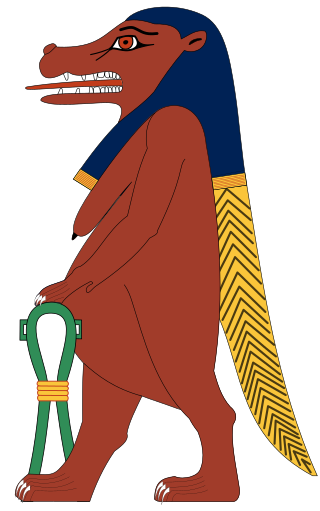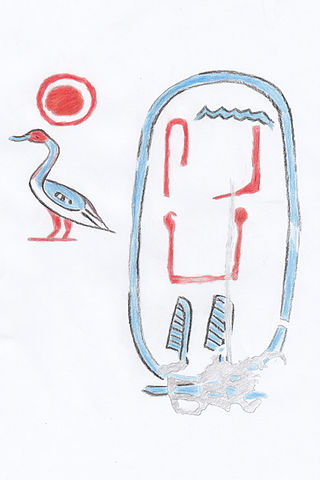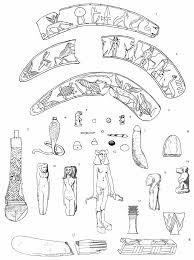
Ammit was an ancient Egyptian goddess with the forequarters of a lion, the hindquarters of a hippopotamus, and the head of a crocodile—the three largest "man-eating" animals known to ancient Egyptians. In ancient Egyptian religion, Ammit played an important role during the funerary ritual, the Judgment of the Dead.

Hathor was a major goddess in ancient Egyptian religion who played a wide variety of roles. As a sky deity, she was the mother or consort of the sky god Horus and the sun god Ra, both of whom were connected with kingship, and thus she was the symbolic mother of their earthly representatives, the pharaohs. She was one of several goddesses who acted as the Eye of Ra, Ra's feminine counterpart, and in this form she had a vengeful aspect that protected him from his enemies. Her beneficent side represented music, dance, joy, love, sexuality, and maternal care, and she acted as the consort of several male deities and the mother of their sons. These two aspects of the goddess exemplified the Egyptian conception of femininity. Hathor crossed boundaries between worlds, helping deceased souls in the transition to the afterlife.

The Middle Kingdom of Egypt is the period in the history of ancient Egypt following a period of political division known as the First Intermediate Period. The Middle Kingdom lasted from approximately 2040 to 1782 BC, stretching from the reunification of Egypt under the reign of Mentuhotep II in the Eleventh Dynasty to the end of the Twelfth Dynasty. The kings of the Eleventh Dynasty ruled from Thebes and the kings of the Twelfth Dynasty ruled from el-Lisht.

A wand is a thin, light-weight rod that is held with one hand, and is traditionally made of wood, but may also be made of other materials, such as metal or plastic. Long versions of wands are often styled in forms of staves or sceptres, which could have large ornamentation on the top.

In Ancient Egyptian religion, Taweret is the protective ancient Egyptian goddess of childbirth and fertility. The name "Taweret" means "she who is great" or simply "great one", a common pacificatory address to dangerous deities. The deity is typically depicted as a bipedal female hippopotamus with feline attributes, pendulous female human breasts, the limbs and paws of a lion, and the back and tail of a Nile crocodile. She commonly bears the epithets "Lady of Heaven", "Mistress of the Horizon", "She Who Removes Water", "Mistress of Pure Water", and "Lady of the Birth House".

Ancient Egyptian art refers to art produced in ancient Egypt between the 6th millennium BC and the 4th century AD, spanning from Prehistoric Egypt until the Christianization of Roman Egypt. It includes paintings, sculptures, drawings on papyrus, faience, jewelry, ivories, architecture, and other art media. It was a conversive tradition whose style changed very little over time. Much of the surviving examples comes from tombs and monuments, giving insight into the ancient Egyptian afterlife beliefs.

The Sixteenth Dynasty of ancient Egypt was a dynasty of pharaohs that ruled the Theban region in Upper Egypt for 70 years.

Khasekhemre Neferhotep I was an Egyptian pharaoh of the mid Thirteenth Dynasty ruling in the second half of the 18th century BC during a time referred to as the late Middle Kingdom or early Second Intermediate Period, depending on the scholar. One of the best attested rulers of the 13th Dynasty, Neferhotep I reigned for 11 years.

Sekhemre Khutawy Sobekhotep was an Egyptian pharaoh of the 13th Dynasty during the Second Intermediate Period, who reigned for at least three years c. 1800 BC.

Apotropaic magic or protective magic is a type of magic intended to turn away harm or evil influences, as in deflecting misfortune or averting the evil eye. Apotropaic observances may also be practiced out of superstition or out of tradition, as in good luck charms, amulets, or gestures such as crossed fingers or knocking on wood. Many different objects and charms were used for protection throughout history.

The Gebel el-Arak Knife, also Jebel el-Arak Knife, is an ivory and flint knife dating from the Naqada II period of Egyptian prehistory, showing Mesopotamian influence. The knife was purchased in 1914 in Cairo by Georges Aaron Bénédite for the Louvre, where it is now on display in the Sully wing, room 633. At the time of its purchase, the knife handle was alleged by the seller to have been found at the site of Gebel el-Arak, but it is today believed to come from Abydos.

Rishi coffins are funerary coffins adorned with a feather design, which were used in Ancient Egypt. They are typical of the Egyptian Second Intermediate Period, circa 1650 to 1550 BC. The name comes from ريشة (risha), Arabic for "feather".

Menwadjre Sihathor was an ephemeral ruler of the 13th Dynasty during the late Middle Kingdom. Sihathor may never have enjoyed an independent reign, possibly only ruling for a few months as a coregent with his brother Neferhotep I.

Woseribre Senebkay was an ancient Egyptian pharaoh during the Second Intermediate Period. The discovery of his tomb in January 2014 supports the existence of an independent Abydos Dynasty, contemporary with the Fifteenth and Sixteenth Dynasties during the Second Intermediate Period.

Sebkay was an ancient Egyptian pharaoh during the Second Intermediate Period. For a long time his position created problems and he was most often placed into the 13th Dynasty. However, the discovery of the tomb of a king with the name Senebkay make it very likely that Sebkay is identical with the latter and the writing of the name Sebkay is just a misspelling of the name.

The Throne of Princess Sitamun is an artefact from the tomb of Yuya and Thuya, which belonged to their granddaughter, Princess Sitamun, the daughter of Pharaoh Amenhotep III and Queen Tiye of the 18th Dynasty.

S 10 is the modern name given to a monumental ancient Egyptian tomb complex at Abydos in Egypt. The tomb is most likely royal and dates to the mid-13th Dynasty. Finds from nearby tombs indicate that S10 suffered extensive state-sanctioned stone and grave robbing during the Second Intermediate Period, only a few decades after its construction, as well as during the later Roman and Coptic periods. These finds also show that S10 was used for an actual burial and belonged to a king "Sobekhotep", now believed to be pharaoh Sobekhotep IV. According to the Egyptologist Josef W. Wegner who excavated S10, the tomb might originally have been capped by a pyramid, although Aidan Dodson states that it is still unclear whether S10 was a pyramid or a mastaba.
Wah-Sut is a town located south of Abydos in Middle Egypt. The name of the town indicates that it was originally built as an outlying part of Abydos, set up by the Egyptian state as housing for the people working in and around the funerary complex of pharaoh Senusret III of the Twelfth Dynasty, at the peak of the Middle Kingdom.

The Ramesseum magician's box is a container discovered in 1885–1886 in a tomb underneath the Ramesseum by Flinders Petrie and James Quibell, containing papyri and items related to magical practices.



















